The Cornell Lab Bird Academy › Discussion Groups › Nature Journaling and Field Sketching › Jump Right in!
-
 Having the still photo made me want to spend a lot of time getting it perfect. I kept it quick to practice drawing quickly in the field. Excited to start practicing with color and being able to document more of the colors I see.
Having the still photo made me want to spend a lot of time getting it perfect. I kept it quick to practice drawing quickly in the field. Excited to start practicing with color and being able to document more of the colors I see. -
 This was a great first assignment - because I didn't have to be perfect! I've got a long way to go but I've made the first step and feel like I can really enjoy this!
This was a great first assignment - because I didn't have to be perfect! I've got a long way to go but I've made the first step and feel like I can really enjoy this! -
Feet are hard! And also getting over t he fact that my drawing wasn't going to be "good." I can get unreasonably frustrated when what I draw doesn't match what I imagine my drawing will be like. I loved the noticing. The different zones of feathers, the way the branch bent and so on. Otherwise I might have just thought-pretty warbler--and moved on.
-
It helped drawing from a photo because the bird sat still, unlike most of them in real life! I was able to take my time to notice details. Because I was drawing, I really tried to pay attention to the details on the bird - eye placement was hard and I had to duo it twice, and it may not be right yet. I didn't take more than about 20 minutes or so on the drawing and didn't get into journaling on this assignment, but I hope to be more detailed in future assignments. I figured this was a warm up!

-
Drawing the photo was challenging for me. I am NOT an artist. None of it came easily for me. But I think the biggest challenge is the patience to get all of the details in. I would not have noticed the moss and lichen if I had not drawn this. I am lacking details on the warbler, but I hope I can get better. I am excited to learn how to journal and sketch!

-

-
1. I felt fine about trying to capture what I saw. I wondered if by getting the shapes as accurate as possible if I would be able to capture the facial expression (I didn't ). It was easy to get started and try. It was hard to get the proportions right. I felt like I was trying to be faithful to the details, but didn't capture the Whole or the essence. 2. I don't think I would have noticed the different layers of feathers... the short ones over the longer ones.

-
 This was a fun first assignment. The sketch itself didn't take long, and I tried to jot down the scene as quickly as possible to get in the habit of field sketching. Painting from the photo took longer because I had the luxury of taking my time. I tried to loosen up and paint shades of color and textures rather than focus on too much detail. This drawing helped me notice the subtle pallet of colors in the yellow warbler that go beyond yellow.
This was a fun first assignment. The sketch itself didn't take long, and I tried to jot down the scene as quickly as possible to get in the habit of field sketching. Painting from the photo took longer because I had the luxury of taking my time. I tried to loosen up and paint shades of color and textures rather than focus on too much detail. This drawing helped me notice the subtle pallet of colors in the yellow warbler that go beyond yellow. -
I liked drawing from the photo - the bird stayed still I could study coloring & shape easier. His head & beak were challenging, also eye & beak placement. If I wasn’t asked to draw it, I may not have noticed the dark areas of the wing or position of legs.

-
1. I’m comfortable drawing from a photo because I can really zoom in and focus on the small details. Seeing shadows and shading is easy in a photo, however getting the proportions correct is always my biggest challenge. 2. The length of those toes! No way I would see those from afar outside. I was also able to see the great variation in feather colors that I may have just lumped into yellow and black if I were nature journaling.

-
Well, I am blown away by the wonderful sketches and writing I'm observing in everyone's responses. So nice to be part of a group who shares similar interest to me! I enjoyed drawing from the photo as the fact that the subject was still gave me a chance to focus on details and get the shape more or less correct. It also was good to practice sketching in itself as it's been a while. I'm excited to add some colour next. I love playing with a fresh new paintbox! If I had only looked at the photograph, I think would would have noticed most elements but drawing made me pay closer attenttion to the shape of the lichens and moss, and details of the bird I wouldn't have really focused on, such as the placement of the eye and the details of the legs and feet. The different types of feather details I would have just not noticed. I hope to be able to upload some photos of my work if I can get phone and computer to work together! In the meantime I'm so enjoying looking at everyone else's efforts. Great to be in this course.
-
 I found it hard to get the proportions right even though it was a still photo, and the end result has some good aspects but less life like than I dream of being able to do. I noticed the feet much more than I might have as it was tricky to get them to curve around the branch
I found it hard to get the proportions right even though it was a still photo, and the end result has some good aspects but less life like than I dream of being able to do. I noticed the feet much more than I might have as it was tricky to get them to curve around the branch -
 I enjoyed this first sketch, but I didn’t find it easy. I struggled to give it some life - but perhaps drawing from a still photo hampers this too. And it looks flat - I’m not sure about giving it depth. I also found out that I don’t know how the watercolour paints behave... On the plus side - it is a lovely little bird, and I liked looking in detail at the plumage structure, subtle shades and colours. This is what I’m aiming for - a more immersive period of observation. I really don’t know how I’ll cope with a moving subject though, and a fleeting moment to try and catch how a bird looks and moves.
I enjoyed this first sketch, but I didn’t find it easy. I struggled to give it some life - but perhaps drawing from a still photo hampers this too. And it looks flat - I’m not sure about giving it depth. I also found out that I don’t know how the watercolour paints behave... On the plus side - it is a lovely little bird, and I liked looking in detail at the plumage structure, subtle shades and colours. This is what I’m aiming for - a more immersive period of observation. I really don’t know how I’ll cope with a moving subject though, and a fleeting moment to try and catch how a bird looks and moves. -

-
Might be simpler if critters in the field would stay as still as this photo...

-
In all my 66 years, I never even once tried to draw anything, so I had quite a bit of anxiety with my first sketch. As I continued, I noticed I was smiling, inside and out. This exercise was a lesson of “self” for me. I loved it and look forward to many journal entries.

-
Susan, I'm so happy that you discovered your talent!
-
-

-
Drawing from a photo has always been easier for me: 2 dimensional photo to 2 dimensional drawing. What's difficult is getting the proportions correct. I probably would not have noticed the various lichen on the branches!
-
 This was my first attempt at drawing since I was about 9 or 10. Looking forward to seeing what the future lessons can draw out of me. Feeling rather excited about it all.
This was my first attempt at drawing since I was about 9 or 10. Looking forward to seeing what the future lessons can draw out of me. Feeling rather excited about it all. -
 Drawings provide that small capture in time. You may not have enough time to sketch a moving subject or you may miss details. When you’re drawing from a picture, you pay more attention to detail. You don’t feel rushed.
Drawings provide that small capture in time. You may not have enough time to sketch a moving subject or you may miss details. When you’re drawing from a picture, you pay more attention to detail. You don’t feel rushed. -
1. I felt grateful this bird was in profile and in a pretty easy pose to get down— fairly straight body position with the tail just a bit up— and that it was a photo and not moving! Getting the basic shapes— mostly one small circle and two bigger circles— was pretty easy, but getting their proportions right was not easy at all for me, and deciding how and where to overlap them was not easy. Even just sticking to the basic outlines of major feather groups, drawing the feather patterns in was not easy, especially getting the size & proportions and set at the correct angles. The color patterns were pretty straightforward on this bird, even if I’m not very experienced with watercolor. 2. Taking the time to draw the image definitely helped me focus on details that are easy to overlook, such as the angles at which the legs come out of the body, the shapes of the toes before the talons, the different feather patterns (even if I chose not to the draw them today) and how the different feather groups were lying. The way the primaries stack up only really became clear when I was studying the drawing to sketch it. I think if I were outside and nature journaling, rather than rendering from a photo, I’d only have time to notice one or two features in a session in any detail though, looking at birds live as they flit around, but I might be more apt to capture something that represents the birds motion in its environment rather than a static image as in a photograph.

-
 I LOVED doing this exercise! A focused respite on a Friday afternoon. :-) Responses to the prompts are in my sketch. Ahhhh, the satisfied sound at the end of what might have been 30 or 40 minutes of sketching.
I LOVED doing this exercise! A focused respite on a Friday afternoon. :-) Responses to the prompts are in my sketch. Ahhhh, the satisfied sound at the end of what might have been 30 or 40 minutes of sketching. -
Maripat Maripat Maripat It was both fun and a bit nerve wracking to start sketching but once I began I got into the flow. My bird looks a bit stiff to me and too upright but I do like how a did some of the feathers...may just have to draw him again!

-
Drawing the Yellow Warbler from the photo gave me time to study all the intricacies. I miss details when attempting to capture a bird in flight. The challenges for me then are
 connecting by hand what my eye observes-shading, proportion, position, color variation and in the field not being intent on getting the drawing perfect. But I love the feel of moving pencil on paper to capture the essence of the Yellow Warbler.
connecting by hand what my eye observes-shading, proportion, position, color variation and in the field not being intent on getting the drawing perfect. But I love the feel of moving pencil on paper to capture the essence of the Yellow Warbler. -
 Everything was challenging about drawing the bird. My proportions and composition were muddled, I had to change the eye placement and beak direction about four times each and in the end, the bird ended up elsewhere from the photo. But it was good to have given it a try. Drawing definitely turns you into a better observer. I would have never noticed the different types of feathers, the feather pattern in the back, the flatness of a bird´s head and skull, the length of a tail with respect to the body, how shading a background makes an object pop up - even for someone who doesn´t know what she´s doing.
Everything was challenging about drawing the bird. My proportions and composition were muddled, I had to change the eye placement and beak direction about four times each and in the end, the bird ended up elsewhere from the photo. But it was good to have given it a try. Drawing definitely turns you into a better observer. I would have never noticed the different types of feathers, the feather pattern in the back, the flatness of a bird´s head and skull, the length of a tail with respect to the body, how shading a background makes an object pop up - even for someone who doesn´t know what she´s doing. -
I think you did a great job. The bird looks alive!
-
Read More:
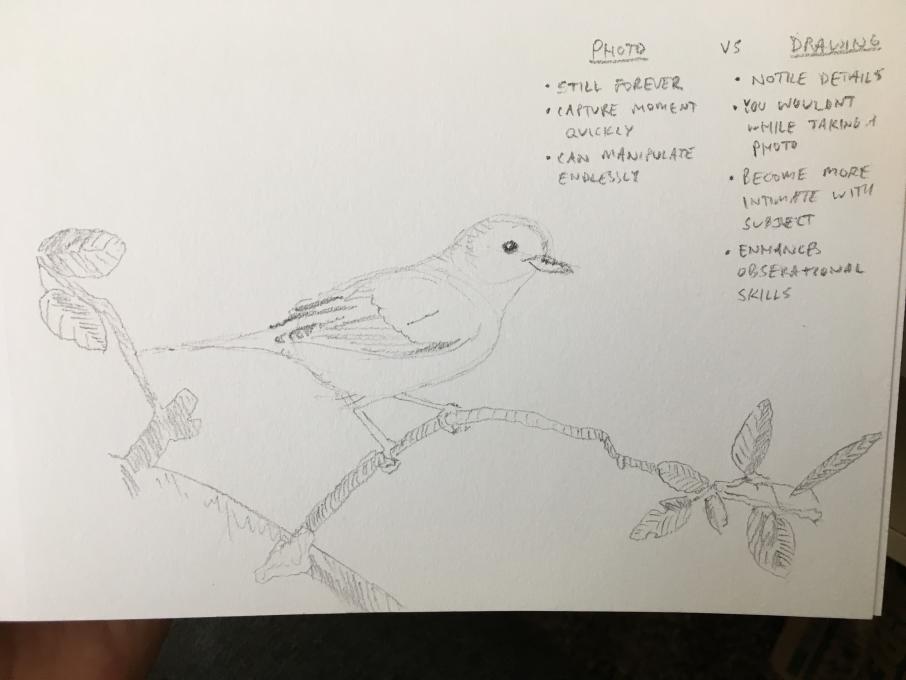 Having the still photo made me want to spend a lot of time getting it perfect. I kept it quick to practice drawing quickly in the field. Excited to start practicing with color and being able to document more of the colors I see.
Having the still photo made me want to spend a lot of time getting it perfect. I kept it quick to practice drawing quickly in the field. Excited to start practicing with color and being able to document more of the colors I see. 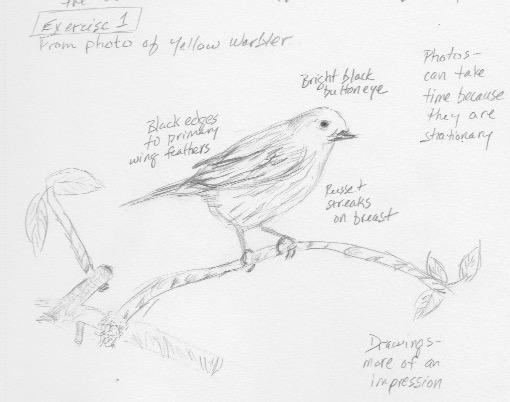 This was a great first assignment - because I didn't have to be perfect! I've got a long way to go but I've made the first step and feel like I can really enjoy this!
This was a great first assignment - because I didn't have to be perfect! I've got a long way to go but I've made the first step and feel like I can really enjoy this! 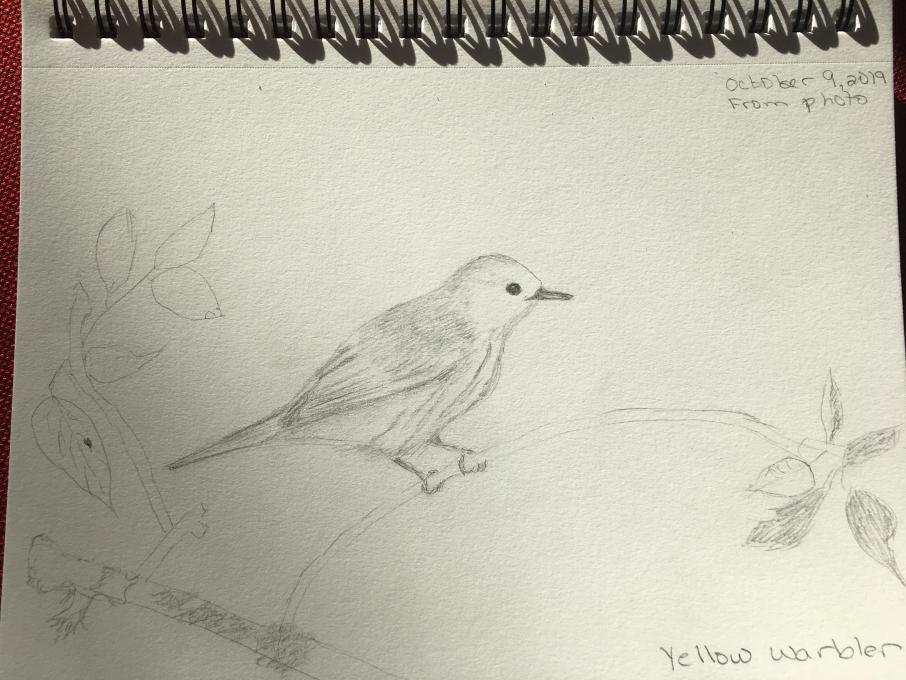
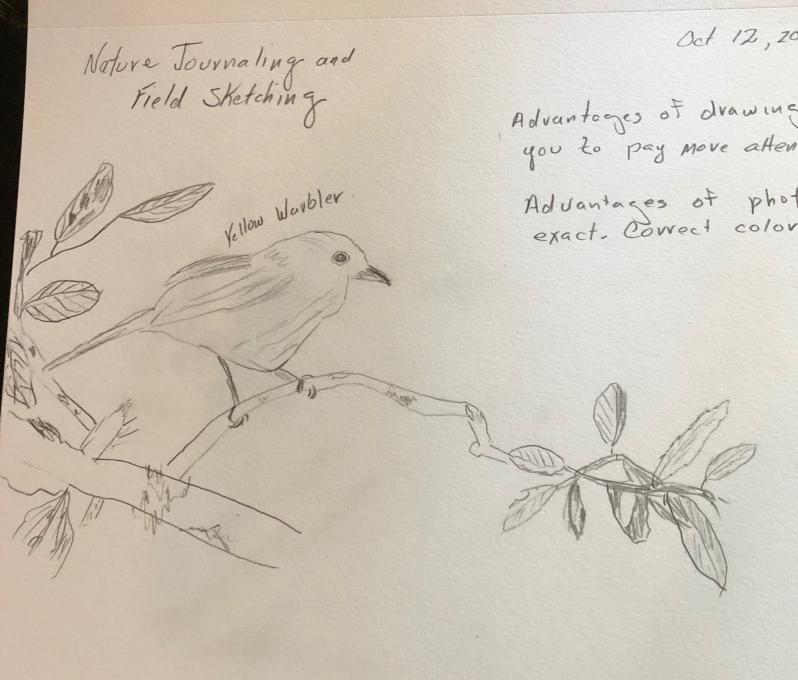

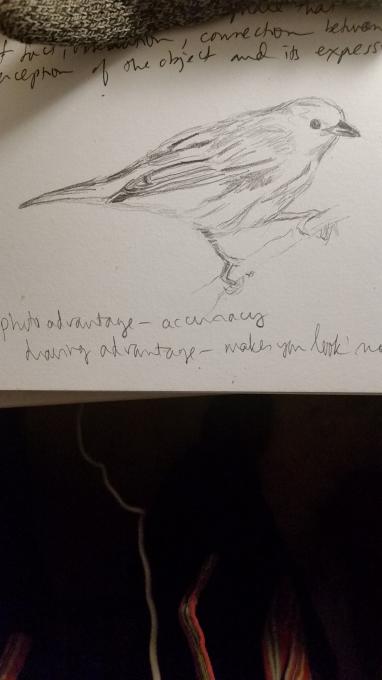
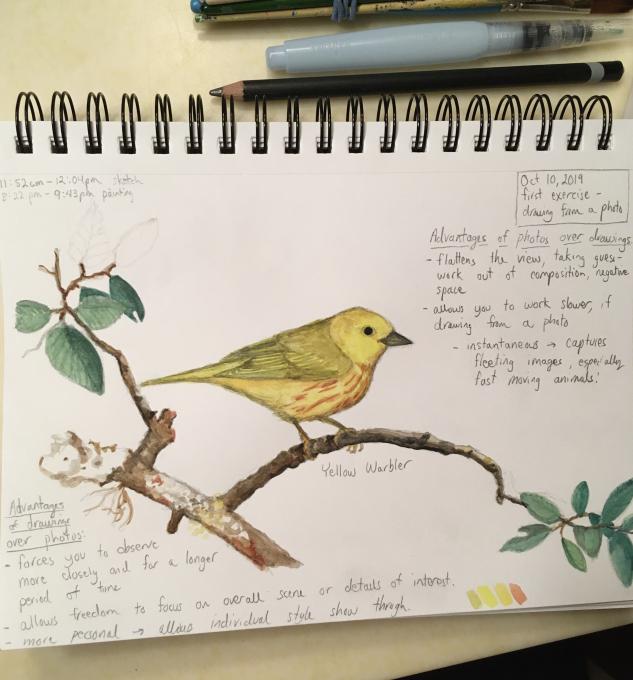 This was a fun first assignment. The sketch itself didn't take long, and I tried to jot down the scene as quickly as possible to get in the habit of field sketching. Painting from the photo took longer because I had the luxury of taking my time. I tried to loosen up and paint shades of color and textures rather than focus on too much detail. This drawing helped me notice the subtle pallet of colors in the yellow warbler that go beyond yellow.
This was a fun first assignment. The sketch itself didn't take long, and I tried to jot down the scene as quickly as possible to get in the habit of field sketching. Painting from the photo took longer because I had the luxury of taking my time. I tried to loosen up and paint shades of color and textures rather than focus on too much detail. This drawing helped me notice the subtle pallet of colors in the yellow warbler that go beyond yellow. 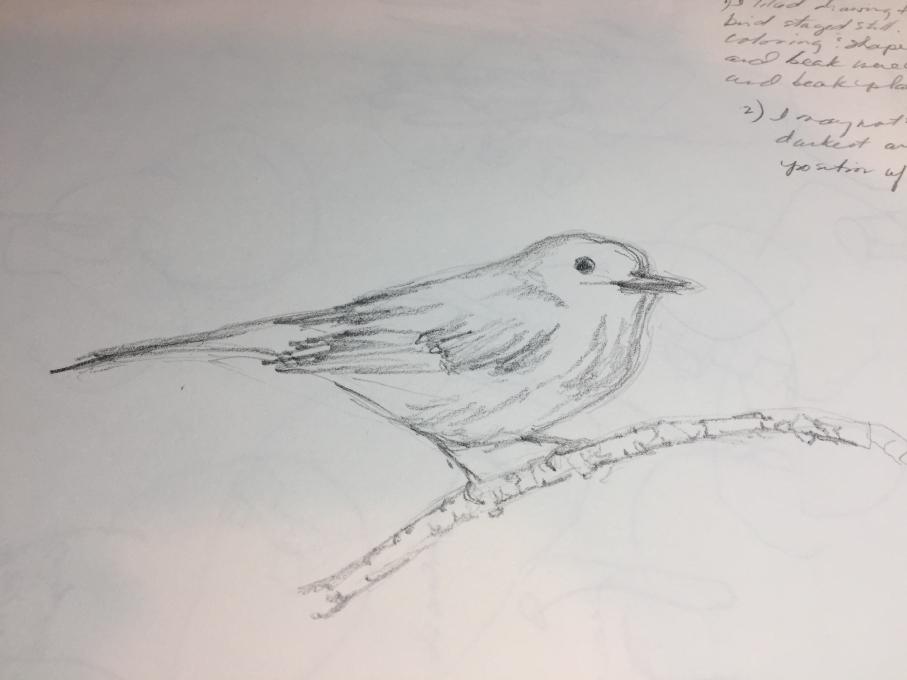
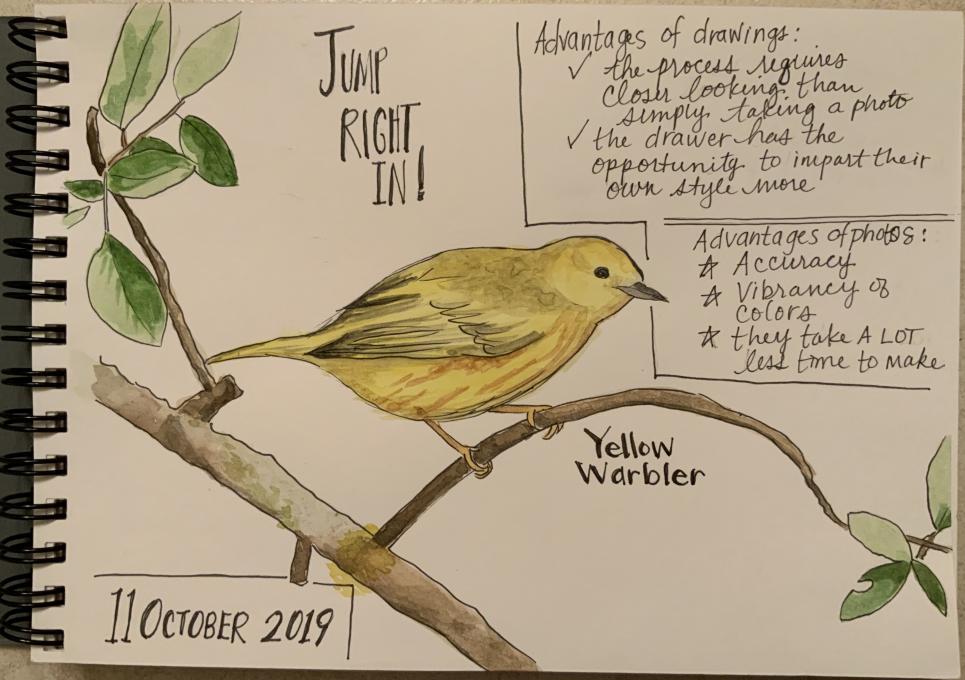
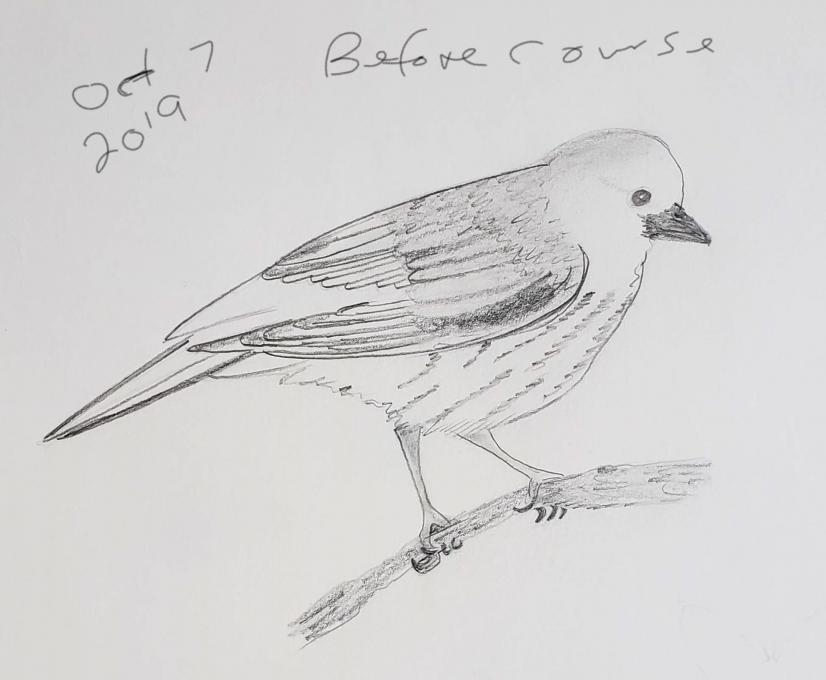 I found it hard to get the proportions right even though it was a still photo, and the end result has some good aspects but less life like than I dream of being able to do. I noticed the feet much more than I might have as it was tricky to get them to curve around the branch
I found it hard to get the proportions right even though it was a still photo, and the end result has some good aspects but less life like than I dream of being able to do. I noticed the feet much more than I might have as it was tricky to get them to curve around the branch 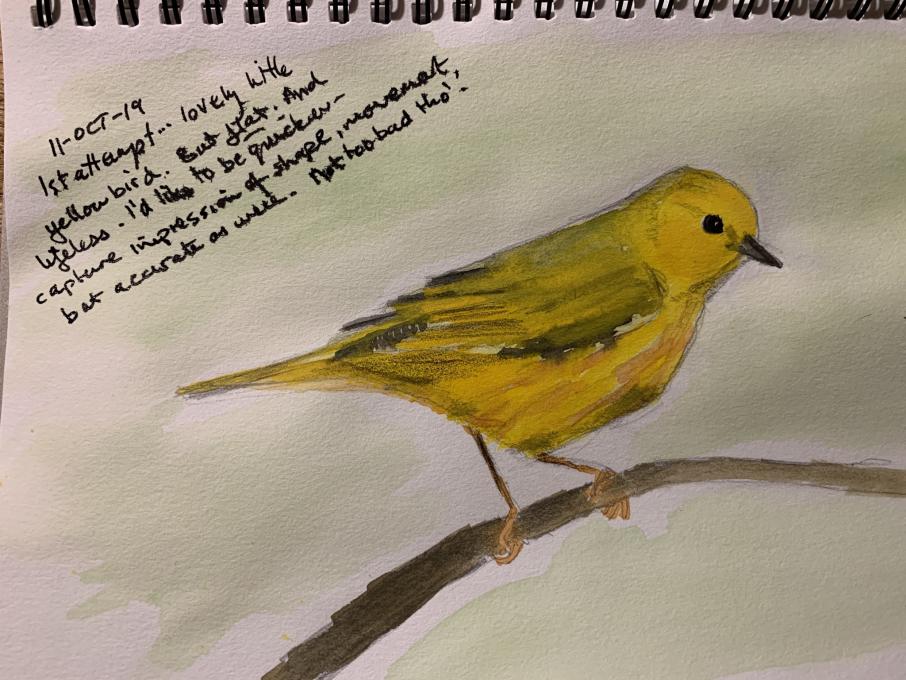 I enjoyed this first sketch, but I didn’t find it easy. I struggled to give it some life - but perhaps drawing from a still photo hampers this too. And it looks flat - I’m not sure about giving it depth. I also found out that I don’t know how the watercolour paints behave... On the plus side - it is a lovely little bird, and I liked looking in detail at the plumage structure, subtle shades and colours. This is what I’m aiming for - a more immersive period of observation. I really don’t know how I’ll cope with a moving subject though, and a fleeting moment to try and catch how a bird looks and moves.
I enjoyed this first sketch, but I didn’t find it easy. I struggled to give it some life - but perhaps drawing from a still photo hampers this too. And it looks flat - I’m not sure about giving it depth. I also found out that I don’t know how the watercolour paints behave... On the plus side - it is a lovely little bird, and I liked looking in detail at the plumage structure, subtle shades and colours. This is what I’m aiming for - a more immersive period of observation. I really don’t know how I’ll cope with a moving subject though, and a fleeting moment to try and catch how a bird looks and moves. 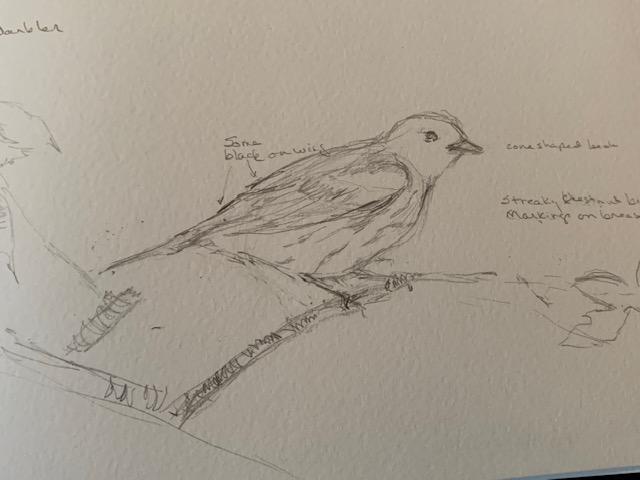

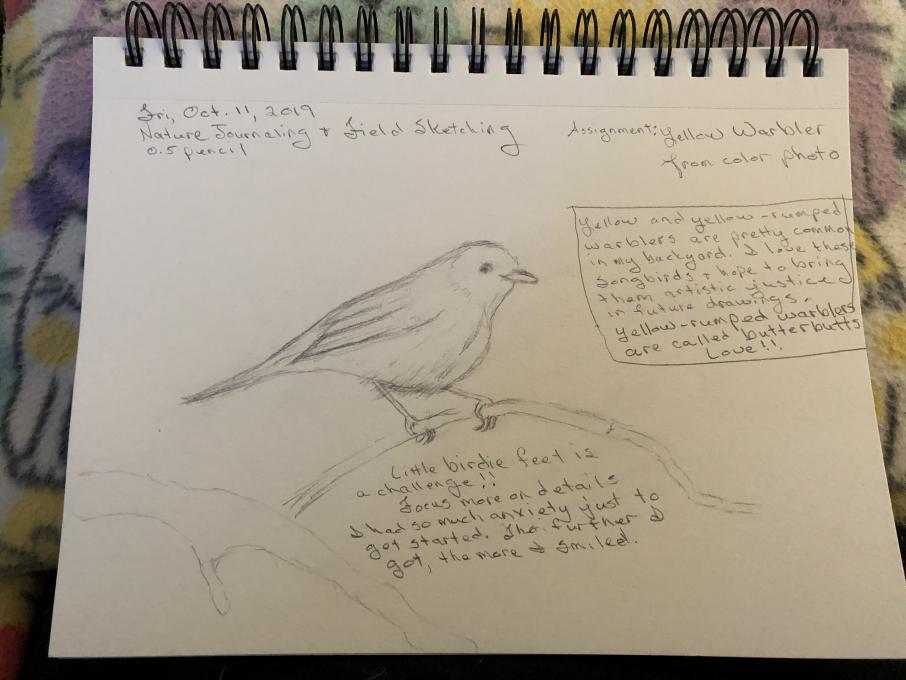
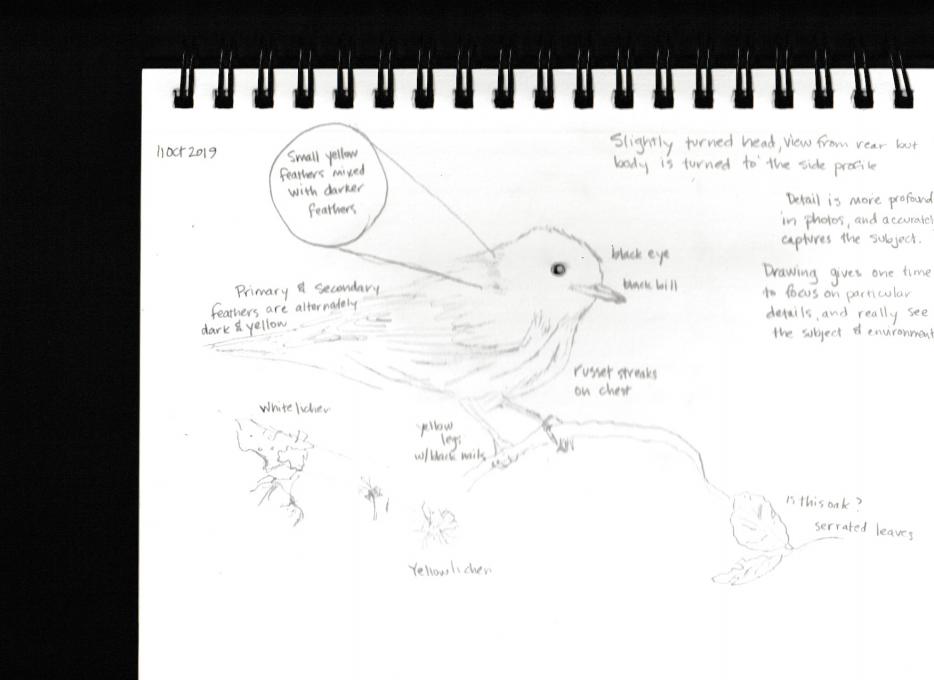
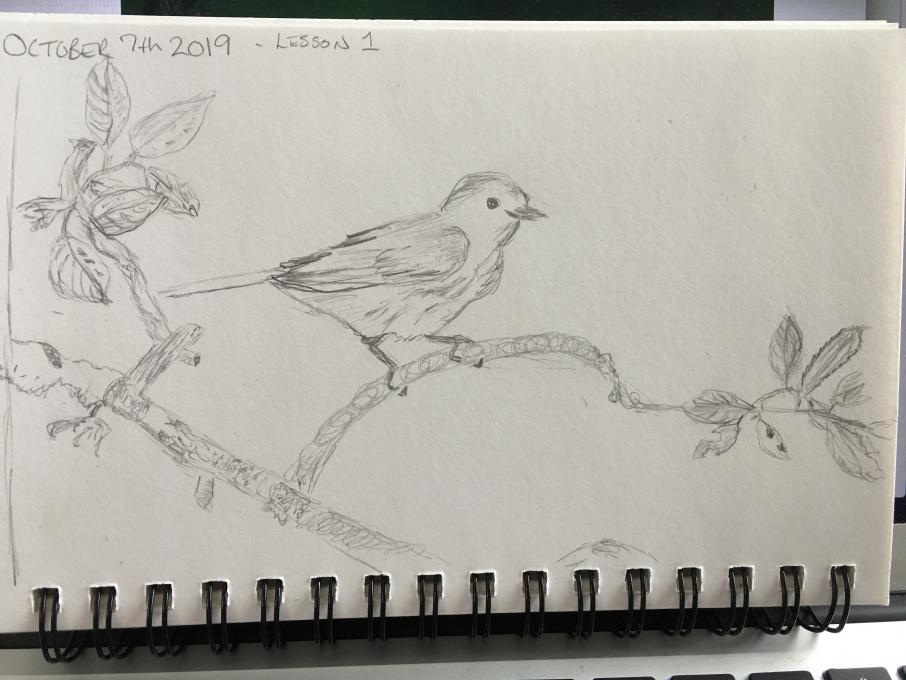 This was my first attempt at drawing since I was about 9 or 10. Looking forward to seeing what the future lessons can draw out of me. Feeling rather excited about it all.
This was my first attempt at drawing since I was about 9 or 10. Looking forward to seeing what the future lessons can draw out of me. Feeling rather excited about it all.  Drawings provide that small capture in time. You may not have enough time to sketch a moving subject or you may miss details. When you’re drawing from a picture, you pay more attention to detail. You don’t feel rushed.
Drawings provide that small capture in time. You may not have enough time to sketch a moving subject or you may miss details. When you’re drawing from a picture, you pay more attention to detail. You don’t feel rushed. 
 I LOVED doing this exercise! A focused respite on a Friday afternoon. :-) Responses to the prompts are in my sketch. Ahhhh, the satisfied sound at the end of what might have been 30 or 40 minutes of sketching.
I LOVED doing this exercise! A focused respite on a Friday afternoon. :-) Responses to the prompts are in my sketch. Ahhhh, the satisfied sound at the end of what might have been 30 or 40 minutes of sketching. 
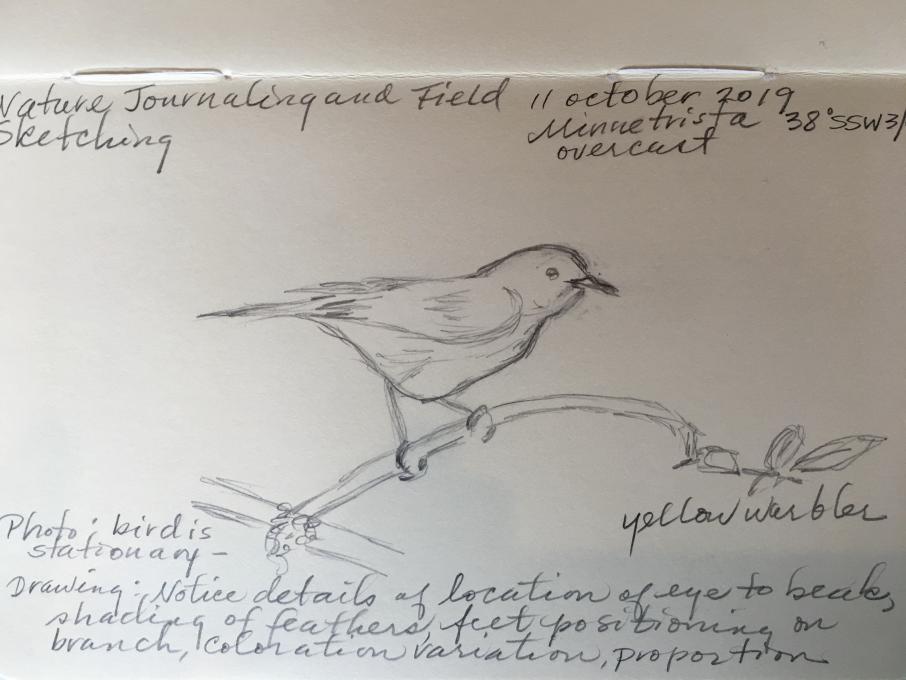 connecting by hand what my eye observes-shading, proportion, position, color variation and in the field not being intent on getting the drawing perfect. But I love the feel of moving pencil on paper to capture the essence of the Yellow Warbler.
connecting by hand what my eye observes-shading, proportion, position, color variation and in the field not being intent on getting the drawing perfect. But I love the feel of moving pencil on paper to capture the essence of the Yellow Warbler.  Everything was challenging about drawing the bird. My proportions and composition were muddled, I had to change the eye placement and beak direction about four times each and in the end, the bird ended up elsewhere from the photo. But it was good to have given it a try. Drawing definitely turns you into a better observer. I would have never noticed the different types of feathers, the feather pattern in the back, the flatness of a bird´s head and skull, the length of a tail with respect to the body, how shading a background makes an object pop up - even for someone who doesn´t know what she´s doing.
Everything was challenging about drawing the bird. My proportions and composition were muddled, I had to change the eye placement and beak direction about four times each and in the end, the bird ended up elsewhere from the photo. But it was good to have given it a try. Drawing definitely turns you into a better observer. I would have never noticed the different types of feathers, the feather pattern in the back, the flatness of a bird´s head and skull, the length of a tail with respect to the body, how shading a background makes an object pop up - even for someone who doesn´t know what she´s doing.